Repeatability and frequency of in-paddock sheep walk-over weights: implications for individual animal management
D. J. Brown A B C D , D. B. Savage A C and G. N. Hinch A CA Cooperative Research Centre for Sheep Industry Innovation, Australia.
B Holmes Sackett, 59C Baylis Street, Wagga Wagga, NSW 2650, Australia.
C School of Environmental and Rural Science, University of New England, Armidale, NSW 2351, Australia.
D Corresponding author. Email: davidb@holmessackett.com.au
Animal Production Science 54(2) 207-213 https://doi.org/10.1071/AN12311
Submitted: 1 September 2012 Accepted: 19 March 2013 Published: 15 May 2013
Abstract
Sheep liveweight is an indicator of nutritional status, and its measure may be used as an aid to nutritional management. When walk-over weighing (WOW), a remote weighing concept for grazing sheep, is combined with radio frequency identification (RFID), resulting ‘RFID-linked WOW’ data may enable the liveweight of individual sheep to be tracked over time. We investigated whether RFID-linked WOW data is sufficiently repeatable and frequent to generate individual liveweight estimates with 95% confidence intervals (95% CI) of <2 kg (a sufficient level of error to account for fluctuating gut fill) for a flock within timeframes suitable for management (1-day and 5-day timeframes). Four flocks of sheep were used to generate RFID-linked WOW datasets. RFID-linked WOW data were organised into three groups: raw (unfiltered), coarse filtered (remove all sheep-weights outside the flock’s liveweight range), and fine filtered (remove all sheep-weights outside a 25% range of a recent flock average reference liveweight). The repeatability of raw (unfiltered) RFID-linked WOW data was low (0.20), while a coarse (0.46) and fine (0.76) data filter improved repeatability. The 95% CI of raw RFID-linked WOW data was 27 kg, and was decreased by a coarse (11 kg) and fine (6 kg) data filter. Increasing the number of raw, coarse and fine-filtered data points to 190, 30 and 12 sheep-weights, respectively, decreased the 95% CI to <2 kg. The mean cumulative percentage of sheep achieving >11 fine-filtered RFID-linked WOW sheep-weights within a 1-day and 5-day timeframe was 0 and 10%, respectively. The null hypothesis was accepted: RFID-linked WOW data had low repeatability and was unable to generate liveweight estimates with a 95% CI of less than 2 kg within a suitable timeframe. Therefore, at this stage, RFID-linked WOW is not recommended for on-farm decision making of individual sheep.
Additional keywords: RFID, sample size, weighing systems.
Introduction
Walk-over weighing (WOW) is an emerging alternative to conventional static weighing and the subjective appraisal of sheep flocks for nutritional management decision-making purposes. It is a method of automated liveweight data collection whereby sheep are encouraged to traverse a strategically placed weighing platform within a paddock as part of their daily routine. The resultant sheep-weights are collected and interpreted by livestock managers to make management decisions on the flock.
The initial concept of WOW incorporated remote individual animal management technology (Richards et al. 2006) in the form of radio frequency identification (RFID) ear tags and readers, and has been the subject of past studies (Richards et al. 2005; Geenty et al. 2007; Lee et al. 2008). Sheep passing over the platform had their weight and individual RFID stamp recorded simultaneously, resulting in a ‘RFID-linked WOW’ record that allowed the liveweight of individual sheep to be tracked over time. This link to individual sheep performance has been cited as the most significant outcome of a trial testing the technology at Bourke, New South Wales, as it allowed for differential management of the sheep based on their respective growth rate (Richards et al. 2006). The RFID technology has been used to enable precision feeding management of individual sheep in a flock, facilitated by an automated ‘in-paddock’ drafting system (Geenty et al. 2007). Other potential benefits of RFID-linked WOW include managing health issues and marketing processes based on growth rates (Richards et al. 2005), and to aid selection of those individuals demonstrating favourable liveweight trends. However, single individual weights were suggested to be inaccurate unless repeated weights over a specific time period were combined to generate an average weight (Richards et al. 2006), and other research has demonstrated difficulties in collecting sufficient data on the flock (Geenty et al. 2007). Previous studies have not estimated the number of sheep-weights required to generate individual liveweight estimates with acceptable accuracy, nor demonstrated the rate of data collection in RFID-linked WOW systems. Despite this, modelling studies have demonstrated that there is potential for improved profitability if RFID-linked WOW is used for differential feeding of sheep in precision sheep management systems (Rowe 2004; Jordan et al. 2006).
Mob-based walk-over weighing (MBWOW) is similar to the original concept of RFID-linked WOW, without the capacity for individual identification provided by the RFID technology. The use of MBWOW technology on a whole-flock basis means that the RFID component can be omitted, and consequently application is simpler and lower in cost (Brown et al. 2012). However, an inferred compromise is that MBWOW does not offer any opportunity for differential management within the flock.
There is little published work pertaining to the accuracy of WOW technology in sheep production systems. Results reported by Brown et al. (2012) showed that MBWOW and static weighing flock average liveweight estimates had a relationship with an r2 >0.8, and consequently mean numeric differences between MBWOW and static flock average liveweight and liveweight change estimates were 1.86 and 1.51 kg, respectively. Any additional accuracy is unlikely because digesta (gut fill) accounts for ~2–5 kg of sheep liveweight (Burrin et al. 1990), and may fluctuate during the sampling timeframes. Grouping data into 5-day groups increases the volume of data for liveweight estimates, and generally improves the relationship between MBWOW and static weighing data (Brown et al. 2012). It has been demonstrated that the repeatability of static weighing data (0.99) is highest, while RFID-linked WOW data filtered by either (i) eliminating all weights outside a 50% range either side of the data mean and without RFID-links (0.35) or (ii), using WeighMatrix, an Excel-based program developed within the Australian Sheep Industry Cooperative Research Centre (CRC), which uses previous liveweight information of individuals (base information) to identify weights that are theoretically incompatible within the current dataset (0.90), was lower (Lee et al. 2008).
There are several reasons why the role of RFID in RFID-linked WOW deserves further investigation. The RFID component of RFID-linked WOW adds a level of complexity and expense and may detract from the practical application of the technology. Furthermore, there is currently no legislative requirement for individual identification of sheep in Australia and few commercial flocks are equipped with RFID ear tags necessary for adoption of the technology. Finally, little research has been performed to test the repeatability or frequency of individual or flock-based liveweight estimations from RFID-linked WOW data.
The objective of this study was to report whether RFID-linked WOW data is sufficiently repeatable and frequent to generate individual liveweight estimates on an entire flock with 95% confidence intervals (95% CI) <2 kg (a suitable level of error to account for fluctuations in digesta) within suitable timeframes (1- and 5-day timeframes) and hence justify the inclusion of RFID into WOW technologies.
Materials and methods
Four flocks were used to generate four RFID-linked WOW datasets (Table 1). Data were collected as sheep passed over a weighing platform as they accessed either an attractant, such as water or salt and molasses, or a sheep camp. Data were not collected on the four flocks represented in this study specifically for differential management of individual sheep in-paddock, but did represent data collection techniques likely to be available to commercial producers.
The Armor, Bookham and Hodgkins flocks were naïve to the WOW equipment before the experiment, whereas the Temora flock had been exposed to the equipment for ~5 weeks as lambs pre-weaning (that is, not naïve). Each flock were exposed to the RFID-linked WOW equipment for a period ranging from 10 to 21 days before data collection, during which time the sheep were encouraged to pass through a bottle neck in the immediate vicinity of the WOW and RFID equipment. This bottle neck was gradually narrowed until the flocks were voluntarily traversing the weighing platform.
Sheep from all flocks were fitted with RFID ear tags. Individual sheep-weights were collected simultaneously with RFID ‘links’, allowing each weight record to be matched with its corresponding sheep, date and time.
Data handling methodology
All sheep that traverse the WOW platform contribute to the RFID-linked WOW data file. The handling of the Armor, Bookham, Hodgkin and Temora datasets was broken down into two phases. The first phase of data handling organises the data into three groups: WOW sheep-weights not linked to RFID stamps; RFID stamps not linked to WOW sheep-weights; and RFID-linked WOW sheep-weights. The second phase of data handling sorts the last group, RFID-linked WOW data (sheep-weights), into a further three groups: raw (unfiltered), coarse filtered (remove all sheep-weights outside the flocks liveweight range), and fine filtered (remove all sheep-weights outside a 25% range of a recent flock average reference liveweight). A reference weight refers to the most recent liveweight estimate for the flock, either a static weighing liveweight estimate or a WOW liveweight estimate. Data was then grouped into either that collected in a 1-day time period (1-day sample) or a 5-day time period (5-day sample).
The three forms of RFID-linked WOW data used in this study were chosen because they demonstrate both the inherent variability of raw RFID-linked WOW data, and the effect of two levels of filtering (coarse and fine) on the repeatability and frequency of the data. The primary purpose of filtering RFID-linked WOW data is to ensure that most ‘half’ and ‘double’ weights have been removed from the dataset. The filtering adopted in this study was similar to that adopted by Lee et al. (2008), and Brown et al. (2012) using WeighMatrix, an Excel-based filtering program developed by the Australian Sheep Industry CRC. It is recognised that additional filtering that takes into account an individual’s past RFID-linked WOW liveweight estimates would increase repeatability (Lee et al. 2008). However, past liveweight estimates from individuals have not yet been shown to be reliable, and hence raw, coarse and fine-filtered RFID-linked WOW data were chosen for the present study.
Analyses
For the four flocks, a total of 82 870 records were collected; 25 001 WOW sheep-weights were not linked to RFID stamps, 22 579 RFID stamps were not linked to WOW sheep-weights, and 32 105 WOW sheep-weights were linked to RFID stamps (RFID-linked WOW data). Of these RFID-linked sheep-weights used in the analysis, 24 419 were within the possible weight ranges of their respective flocks and 21 773 were within a 25% range of a recent reference weight. Statistical significance of relationships was determined using the P < 0.05 criterion and all assumptions of the analysis were met.
Repeatability and power analyses
The repeatability method from Kempthorne (1957) was used, and is described according to the formula r = Var(a)/[Var(a) + Var(r)], where r is repeatability, Var(a) is the estimated variance component between animals (repeated-measures within a 24-h period), and Var(r) is the residual or random variance. These variance components were estimated using a residual maximum likelihood model (Genstat 2011). Repeatability values are provided within and across flocks (pooled) for raw, coarse and fine-filtered RFID-linked WOW data. Multiple RFID-linked WOW sheep-weights from individual sheep over a 24-h period were included in the analysis, while single sheep-weights from the same period were ignored. Repeatability is presented as a decimal, ranging from 0.0 (least repeatable) to 1.0 (most repeatable). Differences between repeatability estimates were not analysed for significance, as repeatability is an extension of the correlation coefficient and reflects the degree of association between separate measures of the same variable.
To determine the effect of the number RFID-linked WOW sheep-weights on the 95% CI (±kg, P < 0.05) of individual liveweight estimates a power analysis was conducted (Statgraphics 2009). The analysis estimated the 95% CI expected for individual liveweight estimates from raw, coarse and fine-filtered RFID-linked WOW data for sample sizes of 1–20 individual sheep. The standard deviation assumptions required for this analysis were derived from the square root of the residual component of the pooled repeatability of the four flocks for each data type.
RFID-linked WOW data frequency
Time taken to collect sheep-weights was calculated from the day sheep began to cross the weighing platform, and in 1- and 5-day samples in order to demonstrate the frequency of RFID-linked WOW data. Based on the outcomes of the repeatability and power analyses, RFID-linked WOW data (either raw, coarse or fine filtered) demonstrating the highest repeatability and the lowest 95% CI were selected for this analysis. The percentage of sheep in each flock achieving sufficient sheep-weights to generate individual liveweight estimates with 95% CI <2 kg was plotted against time. A 95% CI <2 kg criterion was chosen as it allows for fluctuations in digesta (gut fill) (Burrin et al. 1990). The cumulative percentage of sheep in each flock achieving >0, >1, >2… to >19 RFID-linked WOW sheep-weights was also plotted for average 1- and 5-day samples. In order to demonstrate the effect of pre-exposure of sheep to RFID-linked WOW equipment (naïve vs not naïve) the combined percentage of sheep achieving >11 sheep-weights over the first 13 days of data collection from the Armor, Bookham and Hodgkin’s flocks (naïve) were compared with those in the Temora flock (not naïve).
Results
Repeatability of RFID-linked WOW
Within-flock and pooled repeatability of raw, coarse and fine-filtered RFID-linked WOW data was variable and low for the four flocks (Table 2). Within-flock repeatability ranged from 0.0733 (Temora – raw data) to 0.6872 (Hodgkin – fine-filtered data). The pooled repeatability was 0.1981, 0.4607 and 0.7580 for raw, coarse and fine-filtered RFID-linked WOW data, respectively. Given the somewhat restricted weight ranges within each flock (average within flock weight range = 32 kg; pooled weight range = 45 kg), within flock repeatability was only moderate. Comparatively, pooled repeatability was notably higher because this statistic is based on the wider range of observed weights.
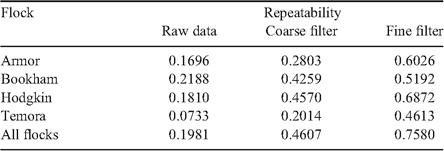
|
95% confidence intervals of RFID-linked WOW
A power analysis was used to estimate the 95% CI (±kg) of raw, coarse and fine-filtered individual RFID-linked WOW data for sample sizes 1–20 sheep-weights. The single raw, coarse or fine-filtered RFID-linked WOW sheep-weight 95% CI was 27, 11 and 6 kg, respectively. As the number of sheep-weights on an individual sheep increased to 20, the 95% CI decreased to 6.1, 2.4 and 1.4 kg for raw, coarse and fine-filtered RFID-linked WOW data, respectively. In order to estimate an individual sheep’s weight within ± 2 kg of its RFID-linked WOW liveweight, the sample size required for raw, coarse and fine-filtered RFID-linked WOW data was 190, 30 and 12 sheep-weights, respectively. In order to satisfy the 95% CI <2 kg criterion, it is assumed the >11 fine-filtered RFID-linked WOW sheep-weights need to be collected to generate a liveweight estimate for an individual sheep within 1- and 5-day timeframes.
RFID-linked WOW data frequency
Filtering reduced the volume of RFID-linked WOW data available for analysis. There were 32 105 RFID-linked WOW sheep-weights across the four flocks. The coarse filter removed 7686 (24%) of these RFID-linked WOW data, while the fine filter removed 10 332 (32%). Based on fine-filtered data having the highest repeatability and smallest required sample size (n = 12) to generate individual liveweight estimates with 95% CI < ±2 kg, it was chosen to demonstrate the percentage of each sheep in each flock achieving >11 RFID-linked WOW sheep-weights over time (record capture frequency). Type of attractant, number of sheep and naivety status of the sheep to RFID-linked WOW equipment was also included. The only flock to collect >11 RFID-linked WOW sheep-weights on the entire flock within the data collection period was Bookham, which took 20 days (Fig. 1). The Armor (18%), Hodgkin (94%) and the Temora (79%) datasets did not achieve >11 RFID-linked WOW sheep-weights for each sheep in the flock within the data collection period. It is important to note that longer data collection periods would increase the likelihood of >11 RFID-linked WOW sheep-weights being collected on the entire flock. This is especially the case for the Temora flock, which demonstrated high record capture frequency, but did not capture >11 RFID-linked WOW sheep-weights on the entire flock because of the short data collection period.
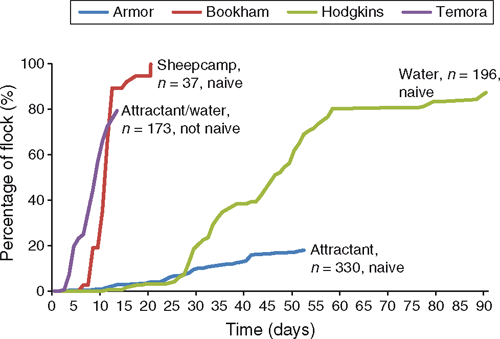
|
The mean cumulative percentage of sheep from the four flocks achieving >0, >1, >2… to >19 RFID-linked WOW sheep-weights for average 1- and 5-day samples is shown in Fig. 2. There was a difference between the mean cumulative percentage of 1- and 5-day samples, with the 1-day samples being lower. The mean cumulative percentage of the four flocks achieving >11 RFID-linked WOW sheep-weights in a 1-day sample was zero, and the pooled cumulative percentage of the four flocks achieving >11 RFID-linked WOW sheep-weights in a 5-day period was only 10 ± 1.7%.
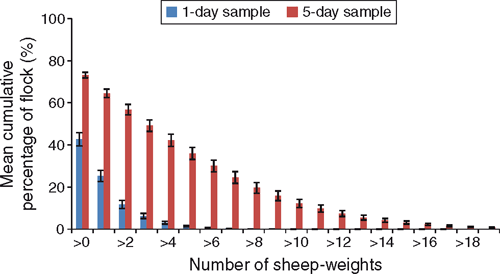
|
The cumulative percentage of sheep in each flock achieving >0, >1, >2… to >19 RFID-linked WOW sheep-weights for average 1- and 5-day samples is shown in Fig. 3 and Fig. 4, respectively. In an average 1-day sample the cumulative percentage of the flock achieving RFID-linked WOW sheep-weights was variable between flocks and decreased with an increasing number of sheep-weights (Fig. 3). The cumulative percentage of the flock achieving >0 sheep-weights ranged between 61 ± 4.8% (Temora and Bookham) and 7 ± 0.5% (Armor). All flocks had less than 50% of individual sheep achieving consecutive sheep-weights (>1 weight record) in an average 1-day sample, and no flocks had individual sheep achieving >11 sheep-weights. The Temora flock was the most frequent data collecting flock, whereas the Armor flock was the least frequent.
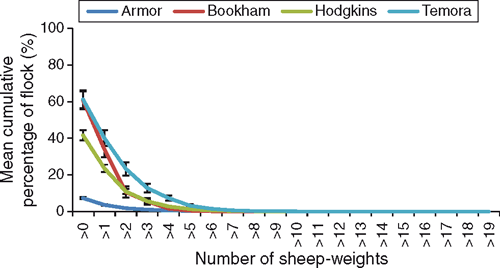
|
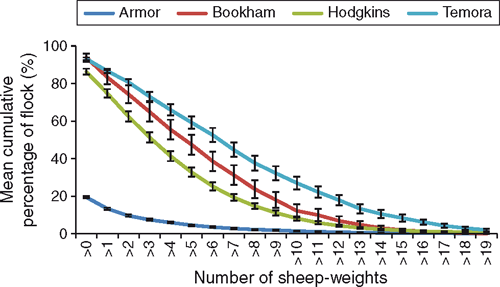
|
The cumulative percentage of the flock achieving RFID-linked WOW sheep-weights in an average 5-day sample was variable between flocks and decreased with an increasing number of sheep-weights (Fig. 4). The cumulative percentage of the flock achieving >0 RFID-linked WOW sheep-weights ranged between 94 ± 2.2% (Bookham) and 19 ± 0.6% (Armor). All flocks except Armor had more than 70% of the flock achieving consecutive weights (>1 weight record) in an average 5-day sample, and the cumulative percentage of the flock achieving >11 sheep-weights ranged from 22 ± 3.0% (Temora) to 1 ± 0.2% (Armor). Again the Temora flock was the most frequent data collection flock, whereas the Armor flock was the least.
Flocks that had been pre-exposed to RFID-linked WOW equipment had higher data collection frequency than their naïve counterparts. The Temora flock (not naïve), achieved >11 sheep-weights for a greater percentage of the flock between 2 and 11 days after the commencement of data collection than did the Armor, Bookham and Hodgkin’s flocks (naïve) flocks combined (Fig. 5). After Day 11 the combined percentage of the naïve flocks achieving >11 sheep-weights was greater than Temora. It is important to note that variables such as sheep class, method of data collection and paddock size need to be considered when interpreting this result.
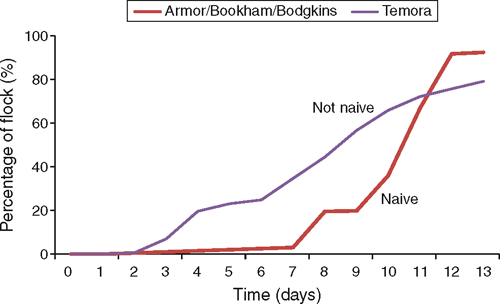
|
Discussion
The objective of this study was to report on the repeatability and frequency of RFID-linked WOW data and the ramifications for individual liveweight estimates of sheep. The results of this study show that raw RFID-linked WOW data repeatability is low (<0.22), a result consistent with similar studies demonstrating repeatability of RFID-linked WOW data (Lee et al. 2008). Filtering with coarse and fine filters increased the repeatability of raw data from approximately 0.2 to >0.4 and >0.7, respectively, but reduced the number of available data points. Observations during the experiment suggest that sheep behaviour contributes to the low repeatability of RFID-linked WOW data because they do not always pass over the platform in a slow, repeatable fashion. Sheep can pass over a platform rapidly, but they can also stop and stand on it for minutes at a time while others attempt to pass. Often a second sheep will stand on the platform before the first sheep steps off. Such behaviours all reduce WOW repeatability.
While the exact reasons for variation in repeatability between flocks is not clear, factors that affect sheep congestion immediately around the weighing platform could be important. These factors may include the number of entry and exit points for access to the attractant, the proximity of the weighing platform to the attractant, the type of attractant, whether the weigh platform is single or multi-directional and the number, class and physiological status of the sheep.
RFID-linked WOW has been promoted as a technology for in-paddock identification of sheep for differential feeding (Jordan et al. 2006). However, the present study demonstrates that the repeatability of raw RFID-linked WOW data, that which would be available for in-paddock decision making, is low. Consequently, the number of sheep-weights required on individual sheep to generate individual liveweight estimates with 95% CI <2 kg is increased. The implications for differential management using RFID-linked WOW are 2-fold: first, any remotely operated equipment that uses RFID-linked WOW to differentiate sheep, such as automatic drafting gates (Geenty et al. 2007), will need to have a ‘real time’ filtering system that filters the incoming data, and be able to collate and average sheep-weights over time both to ensure decisions are not made on incorrect individual sheep-weights. Second, the timeframes required to collect sufficient liveweight information on individuals presents a challenge for effective on-farm decision making. Results from this present study demonstrate that the most frequent data collecting flock (achieving >11 sheep-weights on the entire flock – Bookham) would need RFID-linked WOW equipment to be implemented ~3 weeks in advance to ensure there are sufficient sheep-weights on the entire flock for decision making. We therefore propose that the dynamic and changing nature of commercial on-farm decision making, often subject to external forces such as weather and market conditions, may not be compatible with the large and unpredictable time lag between the implementation of the technology and the chance to make a differential decision on individuals of the entire flock.
The time taken to collect sufficient data on the entire flock may also confound liveweight estimations with daily growth rate. Weights deemed ‘too old’ to be included in an individual’s liveweight estimation may be omitted; however, this reduces that data available for confident liveweight estimates. If 5-day samples (Brown et al. 2012) are considered the maximum timeframe from which RFID-linked weights may be accepted to contribute to an individual’s liveweight estimation, then the average proportion of a flock achieving >11 sheep-weights within this timeframe is 10% (Fig. 2). The flock with the most frequent data collection for 5-day samples, the Temora flock, had only 22% of the flock registering >11 RFID-linked WOW sheep-weights within a 5-day sample (Fig. 4). Consequently it seems that the capacity to collect sufficient sheep-weights for confident liveweight estimation of individuals of the entire flock within a 5-day sample is improbable. Both of these issues suggest that the opportunity for differential management of individuals with RFID-linked WOW may not be possible. Alternatively, what information is available may be extrapolated to make a whole-flock nutritional management decision, which highlights the suitability of the WOW concept for a ‘mob-based’ application as opposed to the management of individuals within a flock.
Reliance of RFID technology on ear tags and remotely powered RFID scanning technology poses a challenge. Approximately 80 sheep from the Armor flock (additional to the 330 included in this study) lost their ear tags through coming into contact with fencing and being pulled from the ear (R. P. Graham, pers. comm.), while insufficient power supply during cloudy weather at Temora hindered data collection. Although the placement of ear tags in the Armor flock was recognised as incorrect and modified for future experiments, and insufficient battery capacity diagnosed at the Temora flock (R. P. Graham, pers. comm.), these incidents highlight the susceptibility of the technology to equipment malfunction.
RFID-linked WOW technology differentiates individual sheep according to their liveweight. As an indicator of nutritional status, liveweight is unable to account for variation in nutritional requirements because of pregnancy status. At approximately mid pregnancy, the range in weights for empty, single- and twin-bearing ewes has been shown to be similar (Jordan et al. 2006). Also, liveweight does not account for animals of differing frame size, with large-framed sheep normally being heavier than their smaller counterparts, despite their nutritional status and current feed requirements. Software that allows a remote drafting system to consider and draft according to ewe pregnancy status and frame size is available (Geenty et al. 2007) and can be used effectively given sufficient background data on individuals, including fetal number, conception date and standard reference weight (an indicator of frame size).
The present study demonstrates that, because of low RFID-linked WOW repeatability, >11 fine-filtered MBWOW sheep-weights are required to estimate liveweight with a 95% CI <2 kg, and is in strong agreement with Filby et al. (1979) for cattle WOW. Collecting sufficient data on the entire flock therefore poses a significant challenge to the application of RFID-linked WOW. In the present study only 43% of data from the four flocks had WOW weights successfully linked to RFID stamps and it is apparent that a sheep crossing the platform does not necessarily correspond to a RFID-linked WOW sheep-weight. Assuming that the remaining 57% of data (that with either RFID or sheep-weights that are not linked) represents forgone usable data, there is an opportunity to increase data collection efficacy by refining the RFID and WOW technologies data collection efficacy and the communication between the two systems.
Generating sufficient motivation to encourage all individuals within a flock to cross the WOW platform is also a challenge facing the application of RFID-linked WOW. Data collection on flocks in the present study was not intended for differential management, yet it is apparent that insufficient data was collected to make use of the individual liveweight estimates, and that what was collected could only be extrapolated to make nutritional management decisions on the whole flock rather than individual animals in a commercial situation. Lack of animal motivation resulting in poor data collection was also encountered in a trial testing the preferential feeding concept at both Chiswick and Turretfield research stations (Geenty et al. 2007). It has been suggested that green pasture conditions reduced the motivation of individuals to traverse the platform to access their watering point (Geenty et al. 2007) while Brown et al. (2012) commented that a flocks’ motivation to traverse the platform probably accounted for much of the variation in the amount of data collected between flocks when assessing MBWOW. The assumption that water may provide a physiological requirement sufficient to motivate sheep to cross a platform is not supported by the present study, although further research during summer months is needed to validate this.
Options to increase data collection frequency have been incorporated into past studies. Gates have been used to segregate sheep as they passed over the weigh scales to limit ‘double’ weights and ensure the drafting mechanism was not jammed by excess sheep, but this may act as a deterrent (Geenty et al. 2007). When data collection is insufficient, sheep have been forced over the platform to increase data collection, yet the increased speed of the sheep resulted in less RFID information being captured (Geenty et al. 2007).
The present study demonstrated that pre-exposure of sheep to RFID-linked WOW equipment will increase data collection frequency in the early stages of data capture. The Temora flock (not naïve), although collecting data for only 13 days, collected more data earlier on each individual sheep than the other three flocks (naïve) combined (Fig. 5). The Temora flock had been exposed to the equipment before the experiment as lambs pre-weaning, suggesting they were less averse to crossing the weighing platform and more likely to have data collected at a faster rate. Other factors affecting data collection frequency, such sheep class, method of data collection and paddock size, warrant further investigation. Previous studies have demonstrated the increased propensity of young sheep to adopt feeding procedures if they had been exposed to them before weaning (Savage et al. 2008), and for sheep to transcend neophobia of novel circumstances through observational learning of their counterparts (Chapple et al. 1987). It has also been recognised that sheep need to learn to use WOW systems voluntarily, as sheep that are forced over the weighing platform often go too fast for accurate data collection (Morris et al. 2012), and may also associate the equipment with stress and become fearful of the context. This ability of sheep to ‘learn’ from past experience will affect the speed in which they adopt the technology (Hutson 1980) and may have implications for the application of the technology where there is little time for training of the sheep, such as its use for liveweight management of weaner sheep over summer periods.
Past research investigating the effectiveness of ‘in-paddock’ differentiation of sheep with RFID-linked WOW technology has proved inconclusive. Results have demonstrated an increase in average weight of sheep preferentially fed using RFID-linked WOW and automatic drafting gates over control sheep, yet there was no decrease in standard deviation in the preferentially fed flock (Geenty et al. 2007). This may have been because of the increasing coefficient of variation associated with the increasing mean weight of the flock. However, it may also indicate that the distribution of weights between the treatment and control flocks remained similar, despite the lighter proportion of the treatment flock supposedly being preferentially fed. The technology used by Geenty et al. (2007) had no facility to filter or average weights before preferential feeding decisions, and therefore we suggest that although the system did preferentially feed some sheep, it did not perform this action in a repeatable manner and hence no reduction in the distribution of liveweight was achieved across the flock. This highlights the need for the development of in-paddock data filtering systems, and more sophisticated assessment of in-paddock differentiation of sheep facilitated by RFID-linked WOW technology.
Conclusion
The objective of this study was to report whether RFID-linked WOW data was sufficiently repeatable to generate individual liveweight estimates on an entire flock with 95% CI <2 kg within a suitable timeframe and hence justify the inclusion of RFID into WOW technologies. Raw RFID-linked WOW data had low repeatability (<0.22) and low frequency; consequently the 95% CI of individual liveweight estimates within 1- and 5-day timeframes were too high (>2 kg) for confident individual liveweight estimates of an entire flock. Filtering the data and increasing the number of sheep-weights to >11 for individual liveweight estimations reduced 95% CI <2 kg. The average timeframe required to collect >11 sheep-weights on individuals was large and variable within and across flocks, and potentially unsuitable for on-farm decision making.
Due to low repeatability of RFID-linked WOW data, investment by the commercial sector into RFID-linked WOW technology is not yet warranted. Future research will need to focus on developing methods to increase the frequency and repeatable transfer of sheep across the WOW platform, as well as the efficacy of data capture and communication between RFID and WOW technologies, and in-paddock data filtering. This will increase RFID-linked WOW data volume and repeatability and allow renewed research into its commercial application for individual differential nutritional management of sheep flocks.
Acknowledgements
This work was generously funded by the Cooperative Research Centre for Sheep Industry Innovation, Australia. The authors thank the Temora Research Institute, including Craig Wilson and Sally Martin, for providing access to their flocks and resources for data collection. Thanks also to Steve Semple and Phillip Graham of the NSW DPI for providing the RFID-linked WOW datasets. A special thanks also to Paul and John Meggison of AusFarm Nutrition for generously providing the attractants for the experiments; David Mayer for his statistical input; and finally to those at Holmes Sackett for their contributions and support throughout the entire experiment.
References
Brown DJ, Savage DB, Hinch GN, Semple SJ (2012) Mob-based walk-over weights: similar to the average of individual static weights? Animal Production Science 52, 613–618.Burrin DG, Ferrell CL, Britton RA, Bauer M (1990) Level of nutrition and visceral organ size and metabolic activity in sheep. The British Journal of Nutrition 64, 439–448.
| Level of nutrition and visceral organ size and metabolic activity in sheep.Crossref | GoogleScholarGoogle Scholar | 1:STN:280:DyaK3M%2FislOjtw%3D%3D&md5=1927069df4fd7b9079bc85f9fa07ed20CAS | 2223745PubMed |
Chapple RS, Wodzicka-Tomaszewska M, Lynch JJ (1987) The learning behaviour of sheep when introduced to wheat. I. Wheat acceptance by sheep and the effect of trough familiarity. Applied Animal Behaviour Science 18, 157–162.
| The learning behaviour of sheep when introduced to wheat. I. Wheat acceptance by sheep and the effect of trough familiarity.Crossref | GoogleScholarGoogle Scholar |
Filby DE, Turner MJB, Street MJ (1979) A walk-through weigher for dairy cows. Journal of Agricultural Engineering Research 24, 67–78.
| A walk-through weigher for dairy cows.Crossref | GoogleScholarGoogle Scholar |
Geenty KG, Smith AJ, Dyall TR, Lee GJ, Smith D, Brewer H, Uphill GC (2007) Remote drafting technology for management of pregnant Merino ewes. In ‘Proceedings from the Recent Advances in Animal Nutrition in Australia’. (Eds P Cronje, N Richards) pp. 223–228. (University of New England Publishing Unit: Armidale)
Genstat (2011) ‘Genstat for Windows. Release 14.1.’ (VSN International Ltd: Oxford)
Hutson GD (1980) The effect of previous experience on sheep movement through yards. Applied Animal Ethology 6, 233–240.
| The effect of previous experience on sheep movement through yards.Crossref | GoogleScholarGoogle Scholar |
Jordan DJ, Hatcher S, Lee GJ, McConnel I, Bowen MK, Della Bosca AJ, Rowe JB (2006) Nutritional management for reproductive efficiency. International Journal of Sheep and Wool Science 54, 35–41.
Kempthorne O (1957) ‘An introduction to genetic statistics.’ (Wiley: Oxford)
Lee GL, Sladek MA, Atkins KD, Semple SJ (2008) Varience components of liveweights of pregnant ewes measured by manual or remote methods, with and without processing by data screening. In ‘Proceedings from the Conference of the Australian Society of Animal Production’. (Eds DG Barber, AR Cowan, AR Anstis) p. 22. (University of Queensland: Brisbane)
Morris JE, Cronin GM, Bush RD (2012) Improving sheep production and welfare in extensive systems through precision sheep management. Animal Production Science 52, 665–670.
Richards JS, Atkins KD, Thompson T, Murray WK (2005) ‘Data retrieval from walk-through-weighing. Sheep updates 2005.’ (Australian Sheep CRC and NSW Department of Primary Industries: Orange)
Richards JS, Atkins KD, Thompson T, Murray WK (2006) Data from walk-over weighing – where are we at? In ‘Proceedings from the Australian Society of Animal Production 26th Biennial Conference’. (Eds NR Adams, KP Croker, DR Lindsay) Short Communication 32. (University of Western Australia: Perth)
Rowe JB (2004) Potential benefits of precision nutrition to increase reproductive efficiency under grazing conditions. Science Access 1, 144–147.
Savage DB, Ferguson DM, Fisher AD, Hinch GN, Mayer DG, Duflou E, Lea JM, Baillie ND, Raue M (2008) Preweaning feed exposure and different feed delivery systems to enhance feed acceptance of sheep. Australian Journal of Experimental Agriculture 48, 1040–1043.
| Preweaning feed exposure and different feed delivery systems to enhance feed acceptance of sheep.Crossref | GoogleScholarGoogle Scholar |
Statgraphics (2009) ‘STATGRAPHICS Centurion XVI.’ (StatPoint Technologies: Warrenton, VA)



